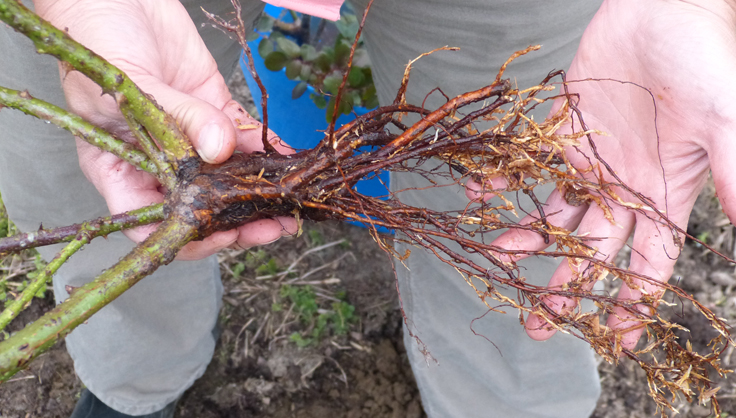How to Plant Bare-Root Trees and Shrubs


A set of bareroot shrubs, as they arrive in a shipment.
Many deciduous trees, shrubs and roses are available as bareroot plants. Growers dig the plants while they're dormant, wash the soil from the roots, and surround the roots in moist packing material prior to shipping. There are several benefits of purchasing bareroot vs. container-grown plants:
- Bareroot plants are usually less expensive.
- They often establish more quickly.
- You may find a larger selection, especially via mail order.
Is your plant in a container or balled-and-burlapped? If so, read How to Plant a Tree or Shrub.
Bareroot plants are sold in spring and must be planted as soon as possible after purchase. Proper planting is critical to their survival and long-term success. Note that bareroot plants are slow to "wake up." Expect to wait four to six weeks after planting until you see signs of growth.
Care Prior to Planting
Open the package and check to make sure the packing material (shredded paper, sawdust or peat moss) around the roots is moist. If it feels dry, sprinkle it with water to moisten it, but don't completely saturate it. For best results, plant within a day or two. If you need to delay planting for a few days, leave plants in their packaging and put them in a cool, shady place. Keep the roots moist and do not allow the plants to freeze.

Remove the packing material from the roots, and then soak the roots in a bucket of tepid water for about 30 to 60 minutes, but not longer than two hours. Keep the roots moist at all times before and during planting.
Digging the Planting Hole
Dig a hole that is twice the diameter of the root spread. If possible, leave a cone of undisturbed soil in the center of the hole. The hole should be deep enough to accommodate the roots without crowding or bending. Adjust the height of the cone so that the crown (where the trunk meets the roots) will sit at or slightly above soil level with the roots spreading downward.
Backfill
The thinking on backfill has changed in recent years. Although it was once common to modify the backfill soil with amendments — such as compost, peat moss, aged manure and other ingredients — it is now considered best practice to leave the backfill unaltered or to add minimal amendments. This encourages roots to spread out into the native soil, rather than staying within the confines of the planting hole.
We do recommend adding mycorrhizal fungi and bone meal to the backfill. Mycorrhizal fungi form associations with plant roots and help them extract and absorb minerals and water from the soil. Trees and shrubs with mycorrhizal-enhanced root systems adapt better and are more tolerant of stressful environments. Bone meal provides essential minerals that promote sturdy root systems and stimulate plant growth.
A Note on Grafted Plants
Most fruit trees and roses are grafted, meaning that each plant consists of two sections. The top is called the scion, and the bottom is called the rootstock. Set grafted plants so the graft union (a swollen area near the base of the trunk or main stem) sits a few inches above soil grade.

Planting and Watering
To plant, spread the roots over the soil cone, adjusting as necessary so the crown sits at the natural soil level. If the soil cone is made of loose soil, plant the crown slightly higher (1/2" to 3/4") to allow for settling after planting. Planting the crown too deep is a common cause of plant failure.
While holding the plant upright, begin backfilling the hole, pressing soil around and between the roots. Use your hands to firm the soil and eliminate air pockets. Continue adding backfill and packing it down until you've filled the hole.
Construct a 3-4" high ridge of soil around the outer edge of the planting hole. This berm will create a basin to hold irrigation water and concentrate it over the roots. Use a hose to fill the basin, and then allow the water to soak in, repeating several times. Or, let the water run at a trickle for 15 to 30 minutes to ensure that the entire root zone is moist. The goal is to ensure even watering so the soil is drenched and any large air pockets are eliminated. Remove any plant tags or labels from the tree.
Mulching
Apply bark mulch or pine straw to a depth of 2-3" over the entire planting hole. Mulching helps conserve water and prevent weeds. Taper the mulch toward the base of the plant.
Staking
Staking at planting time is not always necessary. Consider the stability of the plant and direction and strength of prevailing winds when determining whether or not to stake. If in doubt, ask a nursery professional.
Fertilizing
We do not recommend fertilizing newly planted trees and shrubs during their first year of growth.
Watering
Proper moisture is critical to the survival of your young tree or shrub. The roots should never dry out completely, nor should they be waterlogged. The best way to check soil moisture? Use your finger. Dig down 2-4" just outside the root mass of the plant and water if the soil feels dry. Newly planted shrubs and trees should be checked and watered every other day for the first two weeks. After the first two weeks, limit watering to once a week if less than 1" of rain falls during the week. Thorough soakings that moisten the soil to the entire depth of the root mass are better than frequent light waterings. Our Snip-n-Drip Landscape Soaker System makes it easy to give plants this slow, deep watering.
Print this Article:
Get the Dirt
Stay up to date on new articles and advice. Please fill out the information below.
